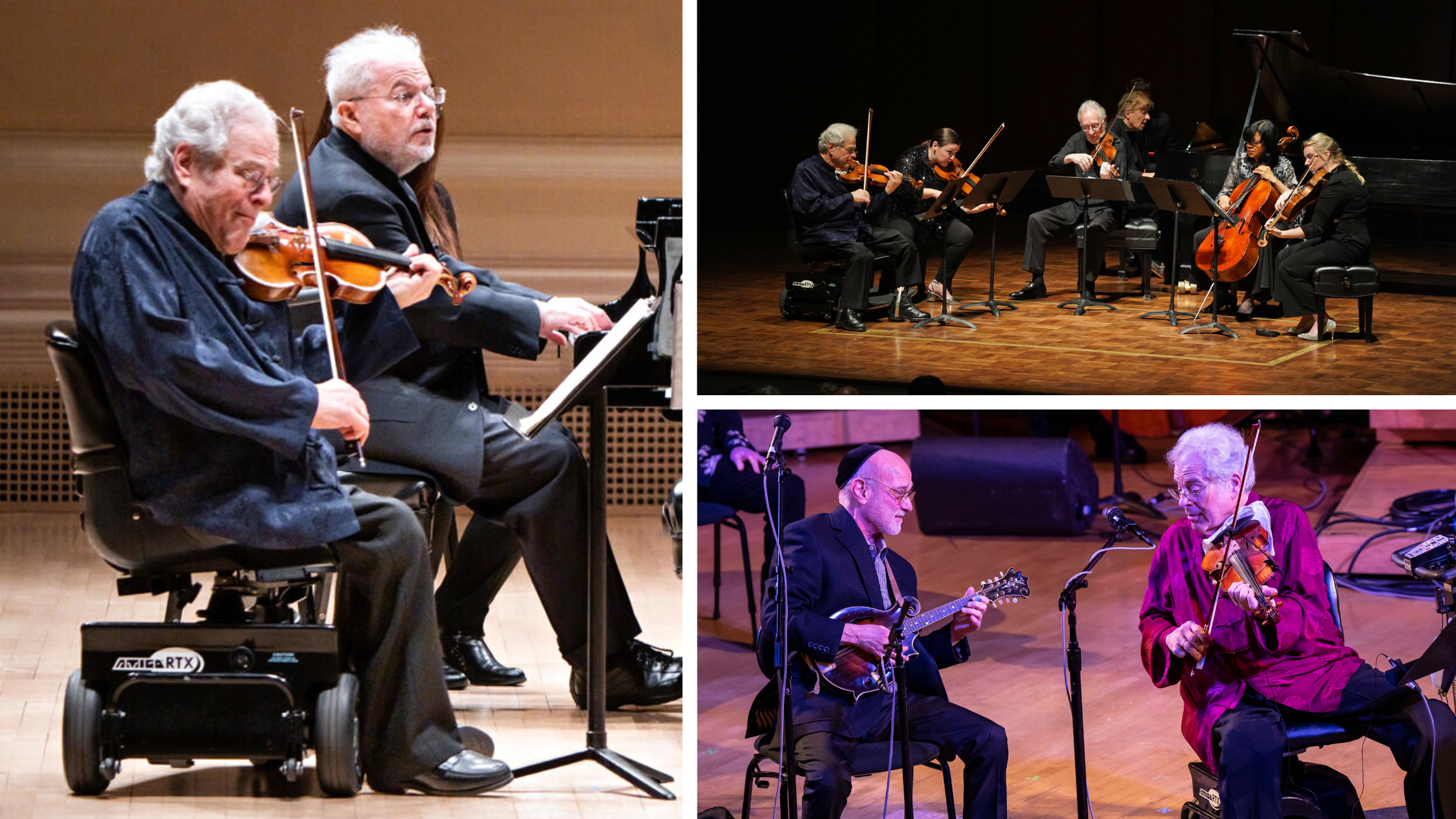Exceptional praise for Itzhak Perlman’s “Itzhak Perlman and Friends” and “In the Fiddler's House” performances
Left: “Itzhak Perlman and Friends” at Carnegie Hall (Photo credit: Chris Lee), Top right: “Itzhak Perlman and Friends” at UMS Ann Arbor (Photo credit: Peter Smith), Bottom right: "In the Fiddler’s House” at Chicago Symphony Center (Photo credit: Todd Rosenberg)
The reviews are in! Critics are raving about Itzhak Perlman’s “Itzhak Perlman and Friends” and “In the Fiddler’s House” performances in Roy Thomson Hall and Chicago’s Symphony Center.
ludwigvanTORONTO wrote:
More than six decades after his debut on the Ed Sullivan Show, Itzhak Perlman has not lost his power to draw a crowd. He still gives the multitudes something to hear, to judge by a concert Monday night in Roy Thomson Hall.
With, it should be stressed, some friends, including the A-list pianists Emanuel Ax and Jean-Yves Thibaudet, and the storied Juilliard String Quartet. It is interesting that the Israeli-American violinist was able to retain a leadership role amid such company without pushing his tone or otherwise compromising the ideals of chamber music.
Formerly famous as clear-eyed purveyors of modernism, the Juilliard players created a texture of remarkable silkiness, leaving just enough room for Perlman, who functioned as a soloist above the fray. His generous vibrato was suited to the idiom. If Thibaudet had his laborious moments at the Steinway, the lavish score never lost momentum. The Liebestod-like surges of the finale earned cheers from the crowd.
Ax was at the keyboard in Mozart’s Piano Quartet No. 2 K. 493. His polished tone was nicely matched to Perlman’s relaxed sound on top. The violinist played the second theme of the first movement with spellbinding lyricism and a touch of portamento. Such indulgences are out of style. Why, then, did the performance seem so purely and effortlessly Mozartian?
ThirdCoastReview wrote:
The 77-year-old Perlman was the big draw for the concert performed Sunday night. It was titled In The Fiddler’s House after a 1996 PBS documentary (and subsequent album) in which the Israel-born Perlman, already a giant of the classical music world, explored Jewish roots music.
Chicago Symphony Orchestra describes Perlman as “undeniably the reigning virtuoso of the violin.” Having appeared with CSO dozens of times since 1966, Perlman was on familiar ground at Orchestra Hall Sunday.
No surprise, then, that Perlman fiddled with the same brilliance and perfect pitch for which he is known in classical venues.
The troubled history of Judaism has produced plenty of mournful music, but Sunday’s concert underscored that there is little of that in klezmer. This is party music, dance music, music to bring joy and entertainment to the hard lives lived by many of its European listeners.
Together with Perlman they produced a toe-tapping, hand-clapping zeitgeist that prevailed throughout the evening—so much so that when Netsky declared the hall a “simcha palace” (a Jewish venue for parties and celebrations) midway through the concert, most attendees got up on their feet and a number of them accepted the invitation to dance in the aisles.
ArtsAtMichigan wrote:
By nature of the profession, musicians are extremely passionate people. Yet, Itzhak Perlman’s dedication and personality somehow stand out among the rest. At 77 years of age, Perlman continues to share his music with audiences across the globe with laid-back, freeform concerts and has no plans of stopping. I had the pleasure of witnessing his collaboration with fellow musicians Emanuel Ax, Jean-Yves Thibaudet, and the Julliard String Quartet in last Friday evening’s concert titled Itzhak Perlman and Friends. This special program will only be performed in two other locations: Toronto’s Roy Thomson Hall and NYC’s Carnegie Hall.
Because I’ve primarily only heard entire orchestras perform in Hill Auditorium, I was a little taken aback when Perlman and violinist Areta Zhulla strolled onstage to immediately launch into Jean-Marie Leclair’s Sonata for Two Violins in E minor. With the two voices alone, the performance felt very exposed–yet abundant chords, trills, and echoing melodies kept the piece satisfyingly rich. Perlman and Zhulla exhibited stunning coordination in articulation, playing with the same creaminess in melodic sections and crispy short notes in the faster parts. Following the piece, we were first introduced to Perlman’s playful practice of fist-bumping his fellow performers.
The next piece, Mozart’s Piano Quartet No. 2 in E-flat Major, featured Perlman alongside pianist Emanuel Ax, violist Molly Carr, and cellist Astrid Schween. Amidst the characteristic delicacy-with-underlying-energy Mozart sound, I felt Ax’s phenomenal ability to inject dynamics and subtle nuances into each phrase shined through in the performance.
Concluding the concert was Chausson’s Concerto for Violin, Piano, and String Quartet featuring Perlman with pianist Jean-Yves Thibaudet and the Julliard String Quartet. This ended up being my favorite piece of the program due to the dramatic ebb and flow of sound and “pretty” quality. The piece plays with a bold, 3 note motif that melts into different passages with singing strings and underlying harp-like piano gymnastics. Perlman’s subtle use of emotional stylistic slides was the cherry on top.

